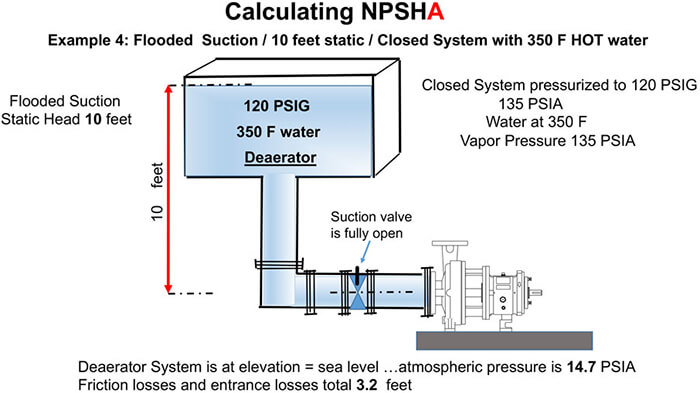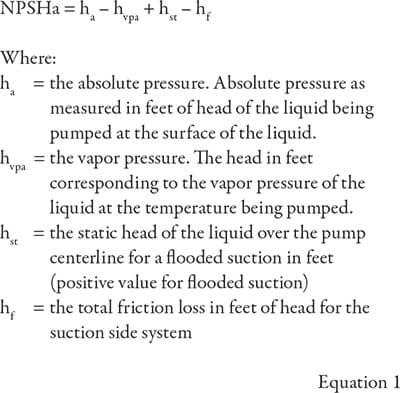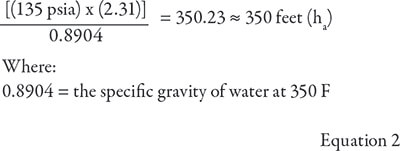Don’t mistake suction pressure for NPSHa.
Summit Pump, Inc.
10/31/2018
This is the fourth article in a five-part series. Read the first part of the series here, the second part of the series here and the third part of the series here.
In the first three parts of this five-part series, we covered the calculation of net positive suction head available (NPSHa) for a flooded suction, a lift condition and a third scenario where the water was hot (212 F) on a flooded suction example. Note we did not go over a hot water lift condition example because these situations are not practical or feasible. The negative aspects of the vapor pressure and the static lift components in conjunction with the friction will negate almost all of the energy that is supplied by atmospheric pressure (habsolute). Always be very careful and circumspect of any hot liquid lift situation for these reasons.
Pressurized Suction Source
The majority of pump applications in North America are installed at elevations below 5,000 feet (reference to sea level). When the system is open to atmospheric pressure, we automatically gain the energy from the air column pushing down on the surface of the liquid. At sea level, we gain 34 feet of absolute pressure and at 5,000 feet above sea level (ASL), we still have 28 feet of energy due to the atmospheric pressure. So far in this series, the examples have been for open systems. This means the liquid supply source was open and subject to the atmospheric pressure for the elevation and barometric conditions at the pump site. Note that just because a tank has a top or cover on it does not mean it is a pressured tank. One of the biggest mistakes I see in new pump applications is the false assumption that suction pressure is equivalent to NPSHa. For more than 47 years, I have unfortunately witnessed this mistake being made time and again. I talk with other technicians, engineers, industry peers and even industry contacts at competitive companies. This common, yet preventable mistake is the major point of this article. Suction pressure is not NPSHa.About This Example
The example for this article (see Image 1) shows a closed and pressurized suction tank at 120 pounds per square inch gauge (psig) and 350 degrees F. Image 1. Flooded suction in closed system with hot water (Image courtesy of the author)
Image 1. Flooded suction in closed system with hot water (Image courtesy of the author)- (gage = absolute – atmospheric)
- (atmosphere = absolute – gage)
- (absolute = gage + atmospheric)
The Formula
I know many of you hate this part, but remember the formula (the equation) is your friend in these examples. If you know the formula you can just “plug” in the values and “chug” through the math to get the correct answer. Remember that we are calculating NPSHa (Equation 1), so we do not need to include velocity head. The water level is 10 feet (10 feet of static head hst) above the pump centerline (Image 1). For this example, let us assume the water level will remain at that height. We will assume the liquid supply rate is the same as the demand rate. In a real world situation, you must calculate NPSHa based on the expected worst case scenario. For example, the application could be a batch process where the tank will be nearly empty at some point. In this case of a deaerator system the level will likely remain the same. For ease in working the example, I have calculated the total friction losses (hf) as 3.2 feet. Note that friction losses are technically lower for hot water than cold, but we will ignore the small difference for the examples in this series.
For ease in working the example, I have calculated the total friction losses (hf) as 3.2 feet. Note that friction losses are technically lower for hot water than cold, but we will ignore the small difference for the examples in this series.
 The tank is closed off to atmospheric pressure and the system is pressurized with steam to 120 psig. The absolute pressure in feet of head (ha) is 350 feet as a result. Remember the formal NPSHa definition for absolute pressure (ha): “the absolute pressure as measured in feet of head of the liquid being pumped at the surface of the liquid.” Depending on which method of conversion of pressure to feet you use, the answer will still round off to 350 feet (Equation 2 and 3).
The tank is closed off to atmospheric pressure and the system is pressurized with steam to 120 psig. The absolute pressure in feet of head (ha) is 350 feet as a result. Remember the formal NPSHa definition for absolute pressure (ha): “the absolute pressure as measured in feet of head of the liquid being pumped at the surface of the liquid.” Depending on which method of conversion of pressure to feet you use, the answer will still round off to 350 feet (Equation 2 and 3).
 The vapor pressure for 350 F water is 134.604 psia. I looked for this value in the Cameron Hydraulic Data Book, but you can find the information in several technical reference sources. I then converted to units of feet (Equation 4).
The vapor pressure for 350 F water is 134.604 psia. I looked for this value in the Cameron Hydraulic Data Book, but you can find the information in several technical reference sources. I then converted to units of feet (Equation 4).

The Calculation
At this point, you have all the data to complete the calculation. All units are in feet at absolute values. NPSHa = ha – hvpa + hst – hf NPSHa = 350 - 350 + 10 – 3.2 = 6.8 ft. Ask yourself if the pump you would select for this application has a net positive suction head required (NPSHr) value of less than 5 feet. In conclusion, many technicians and operators will not bother to conduct the NPSHa calculations because the suction pressure of 120 psig leads to a false belief that it is not necessary. Do not let it happen to you. The mistake is very costly to correct. References Cameron Hydraulic Data Book 19th Edition
To read other articles in the 'Common Pumping Mistakes' column, go here.

